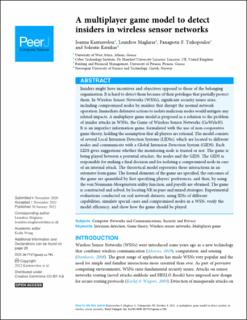| dc.contributor.author | Kantzavelou, Ioanna | |
| dc.contributor.author | Maglaras, Leandros | |
| dc.contributor.author | Tzikopoulos, Panagiotis F. | |
| dc.contributor.author | Katsikas, Sokratis | |
| dc.date.accessioned | 2023-01-20T08:56:16Z | |
| dc.date.available | 2023-01-20T08:56:16Z | |
| dc.date.created | 2022-04-03T13:46:05Z | |
| dc.date.issued | 2022 | |
| dc.identifier.citation | PeerJ Computer Science. 2022, 8 . | en_US |
| dc.identifier.issn | 2376-5992 | |
| dc.identifier.uri | https://hdl.handle.net/11250/3044834 | |
| dc.description.abstract | Insiders might have incentives and objectives opposed to those of the belonging organization. It is hard to detect them because of their privileges that partially protect them. In Wireless Sensor Networks (WSNs), significant security issues arise, including compromised nodes by insiders that disrupt the normal network operation. Immediate defensive actions to isolate malicious nodes would mitigate any related impacts. A multiplayer game model is proposed as a solution to the problem of insider attacks in WSNs, the Game of Wireless Sensor Networks (GoWiSeN). It is an imperfect information game, formulated with the use of non-cooperative game theory, holding the assumption that all players are rational. The model consists of several Local Intrusion Detection Systems (LIDSs), which are located to different nodes and communicate with a Global Intrusion Detection System (GIDS). Each LIDS gives suggestions whether the monitoring node is trusted or not. The game is being played between a potential attacker, the nodes and the GIDS. The GIDS is responsible for making a final decision and for isolating a compromised node in case of an internal attack. The theoretical model represents these interactions in an extensive form game. The formal elements of the game are specified, the outcomes of the game are quantified by first specifying players’ preferences, and then, by using the von Neumann-Morgenstern utility function, and payoffs are obtained. The game is constructed and solved, by locating NE in pure and mixed strategies. Experimental evaluations conducted on real network datasets, using IDSs of different capabilities, simulate special cases and compromised nodes in a WSN, verify the model efficiency, and show how the game should be played. | en_US |
| dc.language.iso | eng | en_US |
| dc.publisher | PeerJ | en_US |
| dc.rights | Navngivelse 4.0 Internasjonal | * |
| dc.rights.uri | http://creativecommons.org/licenses/by/4.0/deed.no | * |
| dc.title | A multiplayer game model to detect insiders in wireless sensor networks | en_US |
| dc.title.alternative | A multiplayer game model to detect insiders in wireless sensor networks | en_US |
| dc.type | Peer reviewed | en_US |
| dc.type | Journal article | en_US |
| dc.description.version | publishedVersion | en_US |
| dc.source.pagenumber | 0 | en_US |
| dc.source.volume | 8 | en_US |
| dc.source.journal | PeerJ Computer Science | en_US |
| dc.identifier.doi | 10.7717/PEERJ-CS.791 | |
| dc.identifier.cristin | 2014866 | |
| dc.relation.project | Norges forskningsråd: 310105 | en_US |
| cristin.ispublished | true | |
| cristin.fulltext | original | |
| cristin.qualitycode | 1 | |

